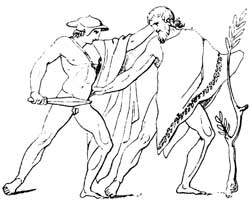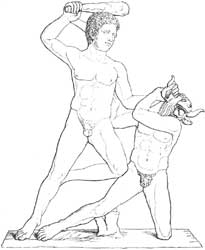Theseus
The great legendary hero of Attica, is one of those mythological personages, whose legends it is by no means easy to disentangle, and represent in their original shape. The later belief of the Athenians, adopted and strengthened by writers of authority, represented him as a very much more historical person than he really was; and, in consequence, the rationalistic mythologists took considerable pains to draw up a narrative of his life in which the supernatural should be kept as much as possible in the back ground, and the character in which the Athenians loved to regard him, as the founder of Attic nationality, be exhibited in as prominent a light as the received traditions allowed. This was avowedly the method upon which Plutarch proceeded.
According to the commonly received traditions Theseus was the son of Aegeus, king of Athens, and Aethra, the daughter of Pittheus, king of Troezen. Other legends, however, maintained their ground, which represented him as the son of Poseidon by Aethra.1 When no reached maturity, Theseus, by his mother's directions took the sword and sandals, the tokens which had been left by Aegeus, and proceeded to Athens. Eager to emulate Heracles, he went by land, displaying his prowess by destroying the robbers and monsters that infested the country. Periphetes, Sinis, Phaea the Cromyonian sow, Sciron, Cercyon, and Procrustes fell before the invincible hero. Arrived at Cephisus, he was purified by the Phytalidae.
At Athens he was immediately recognized by Medea, who laid a plot for poisoning him at a banquet to which he was invited. By means of the sword which he carried, Theseus was recognized by Aegeus, acknowledged as his son, and declared his successor. The sons of Pallas, thus disappointed in their hopes of succeeding to the throne, attempted to secure the succession by violence, and declared war; but, being betrayed by the herald Leos, were destroyed.

The capture of the Marathonian bull was the next exploit of Theseus.2 It was this same enterprise in which Androgeus, the son of Minos had perished. When the occasion returned on which the Athenians had to send to Minos their tribute of seven youths and seven maidens, Theseus voluntarily offered himself as one of the youths, with the design of slaying the Minotaur, or perishing in the attempt. When they arrived at Crete, Ariadne, the daughter of Minos, became enamored of Theseus, and provided him with a sword with which he slew the Minotaur, and a clue of thread by which he found his way out of the labyrinth. Having effected his object, and rescued the band of victims, Theseus set sail, carrying off Ariadne.3
There were various accounts about Ariadne, but most of them spoke of Theseus as having either lost or abandoned Ariadne on the island of Naxos. He was generally believed to have had by her two sons, Oenopion and Staphylus. As the vessel in which they sailed approached Attica, they neglected to hoist the white sail, which was to have been the signal that the expedition had had a prosperous issue. The neglect led to the death of Aegeus. A vessel was in existence up to the time of Demetrius Phalereus, which it was pretended was the very ship in which Theseus had sailed to Crete. It was this vessel which was sent every year to Delos with the sacred envoys. It is worth noting, that although Homer mentions Ariadne as having been carried off by Theseus from Crete,4 he says nothing about the Minotaur. All that part of the story is probably a later addition. The expedition to Crete was probably, in its original form, only one of the somewhat numerous amatory adventures of Theseus. several of which are noticed by Plutarch.5 Soon after he landed, Theseus is said to have instituted the festival termed Oschophoria.6 The origin of the Pyanepsia, and the reinstitution of the Isthmian games, were also ascribed to Theseus.
One of the most renowned of the adventures of Theseus was his expedition against the Amazons. He is said to have assailed them before they had recovered from the attack of Heracles, and to have carried off their queen Antiope. The Amazons in their turn invaded Attica, and penetrated into Athens itself, the final battle in which Theseus overcame them having been fought in the very midst of the city. Of the literal truth of this fact Plutarch7 finds evidence in the names of the localities and the tombs of the fallen Amazons. Cleidemus pretended even to point out the precise position of the contending forces and the fluctuations of the combat.8 By Antiope Theseus was said to have had a son named Hippolytus or Demophon, and after her death to have married Phaedra.
Theseus figures in almost all the ancient heroic undertakings. He was one of the Argonauts (the anachronism of the attempt of Medea to poison him does not seem to have been noticed); he joined in the Calydonian Hunt, and aided Adrastus in recovering the bodies of those slain before Thebes. He contracted a close friendship with Pirithous, and aided him and the Lapiths against the centaurs. Aided by Pirithous he carried off Helen from Sparta while she was quite a girl, and placed her at Aphidnae under the care of Aethra. In return he assisted Peirithous in his attempt to carry off Persephone from the lower world. Pirithous perished in the enterprise, and Theseus was kept in hard durance until he was delivered by Heracles. Later writers endeavored to turn this legend into history by making Pirithous attempt to carry off Core, the daughter of Aidoneus, a king of the Molossians.9 Meantime Castor and Pollux invaded Attica, and carried off Helen and Aethra, Academus having informed the brothers where they were to be found. Menestheus also endeavored to incite the people against Theseus, who on his return found himself unable to re-establish his authority, and retired to Scyros, where he met with a treacherous death at the hands of Lycomedes.
The departed hero was believed to have appeared to aid the Athenians at the battle of Marathon. In 469 BCE a skeleton of large size was found by Cimon in Sevros, and brought to Athens. It was believed to be that of Theseus, in whose honor a temple was erected, in which the bones were deposited. A considerable part of this temple still remains, forming one of the most interesting monuments of Athens. A festival in honor of Theseus was celebrated on the eighth day of each month, especially on the eighth of Pyanepsion. Connected with this festival were two others: the Connideia, in memory of Connidas, the guardian of Theseus; and the Cybernesia, having reference to his voyage.10
There can be little question that Theseus is a purely legendary personage, as thoroughly so as his contemporary Heracles. Nevertheless, in later times the Athenians came to regard him as the author of a very important political revolution in Attica. Before his time Attica had been broken up into a number of petty independent states or townships (twelve is the number generally stated) acknowledging no head, and connected only by a federal union. Theseus, partly through persuasion, partly by force, abolished the separate council chambers and governments, did away with all separate political jurisdiction, and erected Athens into the capital of a single commonwealth. The festival of the Synoecia was celebrated in commemoration of this change. The festival which was called Athenaea was now reinstituted and termed the Panathenaea.11

Theseus is said to have established a constitutional government, retaining in his own hands only certain definite powers and functions. The citizens generally he is said to have distributed into the three classes of Eupatridae, Geomori, and Demiurgi.12 That this consolidation took place some time or other, there can be no doubt. Whether is was accomplished by Theseus is another question. The authority of Thucydides has usually been allowed to settle the matter. Thucydides, however, did but follow the prevailing opinion of his countrymen; and if his belief raises Theseus to the rank of an historical king, it must also make the Trojan war a matter of history.
It is a vain task now to attempt to decide whether there is any historical basis for the accounts of Theseus that were handed down, and still more so to endeavor to separate the historical from the legendary in what has been preserved. The Theseus of the Athenians was a hero who fought the Amazons, and slew the Minotaur, and carried off Helen. A personage who should be nothing more than a wise king, consolidating the Athenian commonwealth, however possible his existence might be, would have no historical reality. It has been urged that we have no ground for denying the personality of Theseus. In matters of this kind the question is rather "Have we any ground for affirming it?" And for this we find nothing but the belief of the Athenians.
The connection of Theseus with Poseidon, the national deity of the Ionic tribes, in various ways (the name Aegeus points to Aegae, the sanctuary of Poseidon), his coming from the Ionic town Troezen, forcing his way through the Isthmus into Attica, and establishing the Isthmia as an Ionic Panegyris, rather suggest that Theseus is, at least in part, the mythological representative of an Ionian immigration into Attica, which, adding perhaps to the strength and importance of Ionian settlers already in the country, might easily have led to that political aggregation of the disjointed elements of the state which is assigned to Theseus. It was probably from the relation in which he stood to the Athenian commonwealth as a whole, that his name was not connected with any particular phyle.13
❧
Shakespeare (A Midsummer Night's Dream) and Chaucer (Knight's Tale) both give the name to the Duke of Athens.
Iconography
Theseus is portrayed as a slender young man, usually beardless, and similar to Heracles armed with a club and wearing a lion's skin. Sometimes he wears a robe and a hat. His exploits are depicted on many antique monuments. The battle with the Centaurs can be found in relief at the temple of Apollo at Bassae-Phigalia (fifth century BCE). An amphora by Euthymides (ca. 500 BCE; Munich) shows the abduction of Helen by Theseus. A bowl by Eurphronius and Panaetius (ca. 480 BCE; Paris) shows Theseus with Amphitrite. His encounter with the Minotaur is painted on a bowl by Aeson (ca. 420 BCE; Madrid) and many other vases.
Pompeian frescoes show Theseus with Ariadne, such as in the Casa del Poeta Tragico, the Casa di Marco Lucrezio Frontone, Casa dell Caccia (presently in Naples), and others. In the Casa del Centenario his battle with the Centaurs is depicted.
References
Notes
- Plutarch. Theseus, 6; Diodorus Siculus, iv, 59; Pausanias. Description of Greece i, 17.3; comp. Aethra.
- comp. Hecale.
- For the variations in the story, given by Cleidemus, the reader is referred to Plutarch. Theseus, 19.
- Odyssey xi, 321.
- Theseus, 29.
- Dictionary of Antiquities, s.v. Oschophoria.
- Theseus, 27.
- Compare the remarkable passage of Aeschylus. Eumenides, 685.
- Plutarch, c. 31.
- Dictionary of Antiquities, s.v. Thescia.
- Thucydides, ii, 15.
- Plutarch. Theseus, 24-26.
- Plutarch, Diodorus Siculus, ll.cc.; Grote. History of Greece, i, 281 ff.; ii, 29; iii, 91; Wachsmuth. Hellenische Alterthumskunde, 40, i, 351 ff; ii, 488.
Sources
- Aken, Dr. A.R.A. van. (1961). Elseviers Mythologische Encyclopedie. Amsterdam: Elsevier.
- Smith, William. (1870). Dictionary of Greek and Roman Biography and Mythology. London: Taylor, Walton, and Maberly.
This article incorporates text from Dictionary of Greek and Roman Biography and Mythology (1870) by William Smith, which is in the public domain.